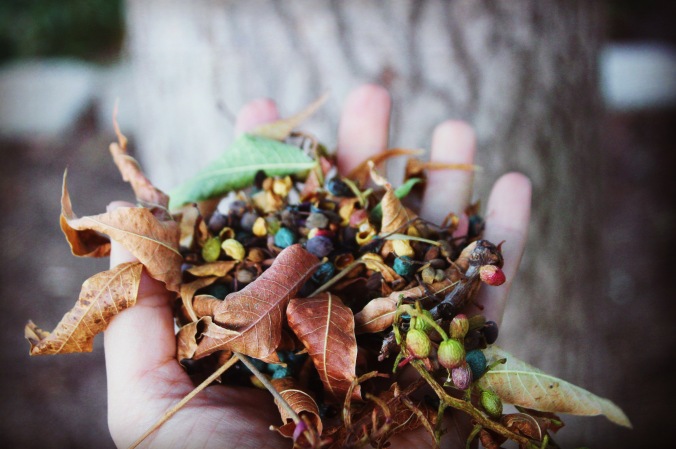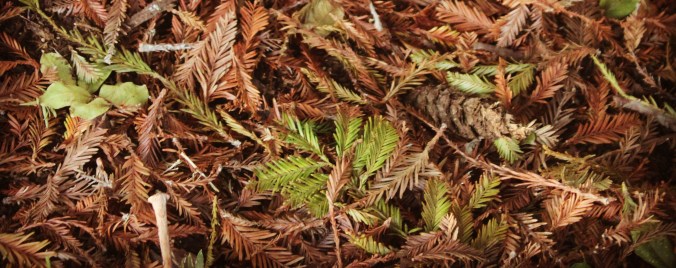Every Fall, nature adorns our trees and shrubs with festive color. The changing scenery practically invokes feelings of warmth and a desire to drink hot apple cider. Or in my case, visit a pumpkin patch – where this year I found an awesome old tractor…

Once the color-glory is over and the leaves begin to blanket the ground, it is easy to lose sight of the big picture – leaf litter, the end of a cycle, is the start of a new cycle for life underneath.
Leaf litter is more than just leaves that fall, leaving you frustrated each year as you must rake them up. Although called “litter,” fallen leaves and other tree components provide a vital service by acting as a mulch and fertilizer and serving as home to numerous insects and helpful bacteria.

Still thinking of those leaves as a nuisance? Let’s explore the many benefits leaf litter in the yard.
Leaf Litter Composition
Trees drop more than leaves, and not only in the fall. You can find twigs, seeds and nuts along with the leaves. Many leaves drop seeds in the spring and a few twigs and leaves all year. Inside this fallen carpet live multitudes of tiny, even microscopic, creatures that use the leaf litter for shelter and food. They help decompose the leaf litter and spread it in a larger area and deeper into the soil as they move around and dig tunnels.

Decomposition
The pieces that make up leaf litter, such as leaves and twigs, are often used in composting heaps, and there’s a good reason for this: they provide valuable nutrients to the soil. As the leaf litter decomposes, nutrients release into the soil making it more fertile and giving it a stronger structure. The bacteria, fungi and insects in the leaf litter break it down, with some excreting nutrients from the leaf litter elsewhere in the garden.

Water Retention
Leaf litter often acts as a mulch for your garden, creating an insulating layer that keeps the ground warm in the winter and helps it retain water throughout the year. The top dries, but the bottom of the leaf litter layer stays moist most of the time. This gives the plants time to absorb the water and nutrients in the soil.

I live in Central Calfornia where summer temps can get as high as 115 degrees. With California facing an epic drought, we are restricted to watering as little as once a week. Leaving leaf litter around my trees, has been an essential way to conserve water my soil and help my thirsty redwood trees make it through the summer!
Erosion
When leaf litter begins to incorporate into the soil, it helps keep the the soil from running off during rain and when you water the yard. The soil in a flower bed is often looser than that under grass, without the intertwined grass root system to hold it in place. Runoff can expose your plants’ roots and cause them to die, but leaf litter helps hold the soil in place.

Wildlife
Leaf litter provides food web essentials for toads, frogs, and lizards. Sheltered in the leaf litter includes food and shelter for earthworms, millipedes, pill bugs, as well as eggs, and larvae of insects and spider. Some of the largest earthworms I’ve ever found, were underneath a bed of leaf litter in my front yard! As the leaves break down, they enrich the soil, provide a down-like comforter for small critters, and benefit at least 120 bird species nationwide. Throughout the fall and winter season, birds scratch through the leaves looking for and finding food. We can help by leaving the leaves. Without this essential food sources, the birds are more likely to leave your garden in search of protein elsewhere.

Here is an American Robin foraging my yard.
Beneficial Bacteria
Leaf litter fosters living soils with vast numbers of beneficial soil bacteria, fungi, and nematodes working in concert to build healthy loam and to nourish plants. If you are interested to learn more about the importance of “living soil”, checkout my post on The Why & How of Garden Soil Amendment.

Aesthetics
As aesthetic humans, we may not want our entire yard covered in leaf litter; and resulting in the leaves blowing throughout the neighborhood. Too many leaves can smother lawns and perennials.

I recommends blowing or raking excessive leaves to an unused area of the yard or compost. I like to rake leaf litter to blanket soil around redwood and fruit trees in my backyard.

You can also use extra leaf litter for a variety of fun crafts – including the stuffing for a scarecrow and Christmas tree ornaments.
As we think of putting our leaf litter to good use, we should be aware that the litter from diseased plants should not be used. Dispose of diseased foliage entirely.

I hope this post inspires you to look at your leaf litter as a benefit instead of a nuisance. As always, happy gardening! For more garden tips, check out Never Enough Thyme on Facebook and Pinterest!

I have a barrel shreader that chews up my leaves, which I store until spring to put on my beds. After 26 years, the results are rich soil, lots of worms and castings for my plants. Nature’s way is the way to go!
LikeLiked by 1 person
Hi Stephanie, my name is Rick Laughlin, APLD, and I think we have some things in common.
I wrote a blog post on saving your leaves about 2 weeks ago. I blog once a week for two years now. I am a certified professional landscape designer with the APLD. Agree 150% on your blog post!
LikeLiked by 1 person
Hi Rick! Sounds like we do have a few things in common. I like your website and blog! I thought about a career in landscape design but ended up in civil engineering instead. Not as much fun as what you do! 🙂 Take care!
LikeLike
Absolutely. I rake leaves onto my vegetable bed and they are soil by the spring time and I leave plenty in corners for hedgehogs and sloe worms. The world needs much more untidy gardens and we will all have much more wildlife!
LikeLiked by 1 person
I agree! 🙂
LikeLike
Have tried composing several times, but alas, I always get rats…
LikeLiked by 1 person
I occasionally have that problem too! 😦 Rats are the worst! Have you tried burying your food scraps you throw in your compost bin? I found that helped to deter the rats along with keeping my compost relatively moist.
LikeLiked by 1 person
will have to try again. prob is also that am in urban neighborhood with houses close together, fruit trees everywhere…
LikeLiked by 1 person
What an interesting article!
LikeLike